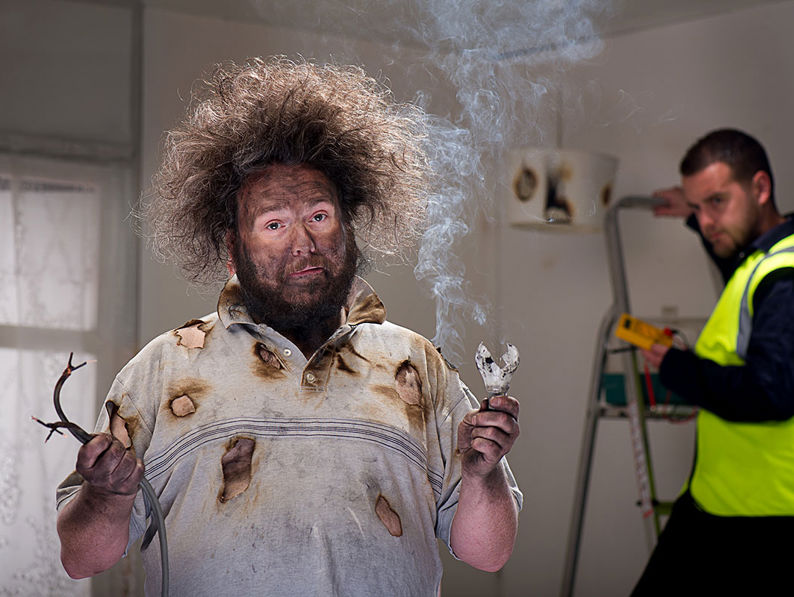How to become a DIY master of your home
As part of our mission to support you with finishing your half-started DIY projects, interior design expert, Siobhan Murphy shares her top tips for tackling a home improvement project.

Whether you’ve recently moved into a new home or have lived in your house for some time, at some point you’ll likely get the itch to finally tackle (or finish!) those long-standing DIY projects around the home.
Shawbrook’s research revealed that more than half (56%) of UK homeowners claim their property is a 'work in progress' and an average of five DIY jobs are currently sitting unfinished in homes across the country.
As part of our mission to support homeowners with finishing their half-started and half-hearted DIY projects, we’ve teamed up with TV star and interior design expert, Siobhan Murphy to share her ultimate tips to tackling a home improvement project in any room of the house – from the kitchen to the garden, and everything in between!
1. The kitchen - aka the hub of the home
The kitchen is the heart of the home, but there is no denying that it is probably one of the most expensive and difficult rooms to makeover. So it’s not a surprise that Shawbrook’s research found one in 10 homeowners have given up on large-scale kitchen improvements halfway through!
To avoid giving up on your kitchen project, my number one tip is to plan, plan, plan! While this goes for all rooms – it rings especially true for a room that can be so costly to re-do. Plus, with many electronic devices to consider, you’d be wise to not rush into anything.
If you’re taking on big structural changes, be sure to map out the exact spot and functionality for each new location. You wouldn’t want to end up with a fridge door that’s blocked by a too-near corner wall!
Also consider how you might finance your kitchen project. There are several different options to choose from so do your research to find out what’s best for you and your budget.
The added expenses that may crop up with a major kitchen project are important to consider too. Costly materials or hiring expert trades people for electrical or plumbing jobs might be required, so be sure to properly work through your budget and requirements ahead of time.
2. Sprucing up your garden
For some sprucing up the garden may be at the top of their priority list. In fact, Shawbrook found that landscaping the garden and remodelling with luxurious features are among the most commonly planned but never finished DIY projects.
To avoid falling into this statistic, my number one garden revamp tip is to tackle the basics first. It’s easy to get carried away with visions (who doesn’t want a Love Island inspired garden with decking and a fire pit?!) but the simplest of updates can turn your garden from drab to dreamy.
Tackle the grass first – is it in need of some love or to be re-planted all together? If you feel it never looks quite right, consider replacing your grass with lawn turf for an extra clean look all year round.
Also consider adding colour by way of extra plants. If flowers aren’t your thing, why not add a vegetable patch? As well as being functional, the pop of colour from tomatoes and hot peppers will add a certain something to your overall look. Consider where your garden is facing, and which areas are best for sunlight so you can choose the right plants for your space.
When it does come to tackling the bigger projects, while jobs like re-decking or re-tiling may seem simple enough to follow via YouTube, one incorrect measurement could leave you feeling totally overwhelmed (and ready to throw in the towel!) so be sure to take your time and don’t rush it.
3. The glorified storage room
It’s not uncommon for spare rooms to become a dumping ground. And if you’re guilty of this, do not fear – that can easily be changed!
Look at your spare room as the one place you can get extra creative. With no one staying in the room regularly, it can be your opportunity to bring your biggest Pinterest inspirations to life (without worrying too much if it’ll fit the taste of your partner, housemate or child!).
To pull the room together, make sure you’ve chosen a core colour theme. The bed should act as your focal point with support from nicely painted or wallpapered walls around it. Once the bed and walls are to your liking, the rest of the design will fall into place.
To ensure the bedroom is safe from the potential of becoming a dumping ground once again, consider adding clever storage options such as floating shelves, under the bed drawers and ottomans.
One of the benefits to tackling the spare bedroom is you’ll have the luxury of time (as long as you don’t have the in-laws making a surprise visit any time soon). So, take it! Compile photos of inspiration, map out exactly what you need to bring the vision to life and stay practical.
4. When painting goes wrong
Unfinished paint jobs are one of my biggest DIY peeves – and unfortunately, it’s a very common one! Shawbrook’s research shows that it’s actually rated in the top three jobs that are abandoned halfway through.
A dreaded DIY feeling is when you’ve finally picked up a large can of a fresh colour, only to realise it’s not at all what you pictured once you’ve got it on the wall. Before committing to such a big pot, I always recommend picking up a tester pot first. Then you can confidently test the colour in that specific room and change your mind without too much paint or money wasted. Consider the lighting and the base colour of the wall as this could impact how the paint will look when it’s on the wall.
Depending on the size of the job, if it is a colour you’re happy to go ahead with, you might be able to get it done with only a few tester pots (saving you loads of money!). Particularly if you decide to have a feature wall, you might not have to get a full pot of paint. Make sure you note down somewhere which room has which type and style of paint in case you need to top up in future.
On the other hand, if you’re looking to tone town the look of a room and go from dark paint to light paint, make sure to consider the amount of paint (and time) required. Dark colours will require a few coats of white before being able to re-paint it to the colour you like.
5. Don’t be afraid to phone a friend
While it’s always frustrating when your DIY project doesn’t go to plan, you’re definitely not alone! Shawbrook found nearly half of homeowners have had a DIY mishap and more than a third are so frustrated by their half-done DIY jobs that they dread coming home to see them!
To avoid mishaps in your future, don’t shy away from help. Call in friends, family and experts to give their ideas and advice before tackling projects – big or small.
There’s also plenty of places to find inspiration and guides to help take you through a potential project – from start to finish. So, make those Pinterest boards, dive deep into DIY TikTok and lean into YouTube before getting started.
Remember, home improvements can come at a cost so always make sure it’s the right option for you and your budget before getting started.
Looking to finance your next home improvement project?
Find out more about our personal loans.
All loans are subject to status. The interest rate offered will vary depending on our assessment of your financial circumstances and your chosen loan amount. Terms and conditions apply.
Shawbrook conducted research with market research company OnePoll to survey 2,000 homeowners in the UK to understand sentiment towards DI-Y home improvements. Research was conducted from 12 May – 16 May 2022.
Related Articles

The biggest barriers to finishing a home improvement
To help you plan for your next project, we reveal the biggest barriers to completing DIY projects around the home according to our research.

We reveal some of the nation's funniest DIY disasters
Looking for DIY ideas? Here’s how not to do it. We surveyed the nation to find the most embarrassing DIY disasters. Here, British comedian Hal Cruttenden reveals some of the funniest entries.

Personal Loan Terminology Glossary
Find a clear A-Z of concise loan terminology definitions in our glossary. Convert jargon into meaningful explanations right here.